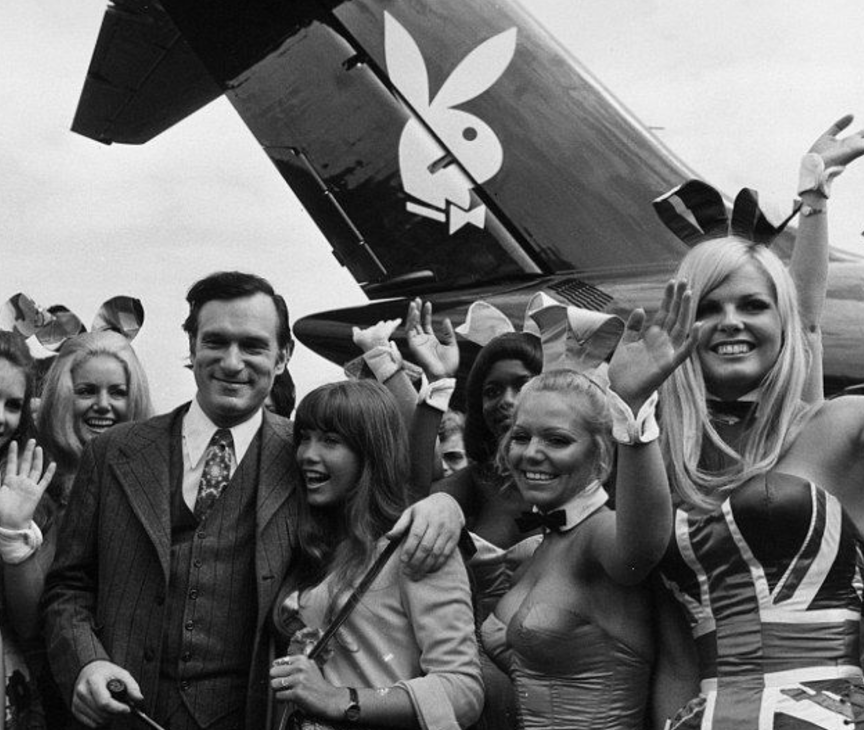Hugh Hefner: deemed a god by some, a lothario of an asshole by others. But no matter who you asked, the general consensus was always that he was a symbol of virility–of what it meant to be masculine in the twentieth century. His ability to get just about any woman no matter how aged he became was the stuff of legend. That, and he made wearing silk robes and pajamas acceptable daytime attire. His role in sparking the sexual revolution of the 60s began in 1953, a time that demarcated the height of McCarthyism and repression–all the cliches the Eisenhower years are now known for, in essence. Yet this was the year the first issue of Playboy was put out into the world, featuring that other emblem of the 50s, Marilyn Monroe, as its centerfold.
That Hef could manage to release a publication like Playboy at a moment such as this clearly spoke to just how desperately men were in need of this, um, outlet. Imagine, if you will, having no access to Tinder, talking to women who were conditioned to give you a dirty look if you weren’t engaged to them and never being able to see much of any skin beneath those high-waisted, below-the-knee poodle skirts. This is what upped the male sex drive–limitations on what he could see and do. But now, and in large part thanks to Hef, all the barriers have been torn down in the twenty-first century, prompting near total male apathy about the formerly coveted bang. Take it or leave it, there’s always porn as a consolation. And soon, porn-themed video games!
When The New York Times questioned him in the early 90s about the achievement he was most proud of, Hef responded, “That I changed attitudes toward sex. That nice people can live together now. That I decontaminated the notion of premarital sex. That gives me great satisfaction.” And changed them he did. No longer was it deemed sinful to express sexual desire, but a natural and healthy way of American life. Shit, it was almost like we had become European in our openness. Almost. It still didn’t stop Hefner’s multiple girlfriends that he lived with at the same time from suing him for palimony.
But more that a libertine, Hef was a shatterer of taboos. Even the literature he chose to include in Playboy (which, yes, few ultimately paid attention to in later years), was defiant. When stodgy Esquire (where Hef had previously worked as a copywriter) rejected sci-fi writer Charles Beaumont’s “The Crooked Man”–a tale of straight men persecuted in a homosexual-favoring society–Hef put it to print. Outrage, naturally, ensued. Hef then dropped the mic by pointing out that if it was wrong to condemn straights in a world of gays then the inverse was just as bad, too.
As the 60s and 70s saw the unstoppable rise of Playboy Enterprises, the archetype of masculinity–a man who chased skirts but also dressed well and took the time to get to know each one of said skirts–rose with it. But with the death of Hef, this epoch of pipe smoking, smooth talking, wining and dining male is sure to be forgotten–occasionally dredged up in classes about censorship or majors in the History of Porn (sure to be implemented at USC any day now). Sure, some might say, “Why would we want Hefner’s brand of masculinity to persist in the future anyway? It was grotesque and exploitive.” Well, the answer, simply, is that some of us don’t want that Barbarella prophecy about sex in the future (taking a pill and touching hands to achieve an O) to come true.
On the plus side, at least Hefner can bone for all of eternity after making good on his purchase of the crypt next to Marilyn Monroe (which he bought for a steal in 1992 at $75,000) at Westwood Village Memorial Park. The current myth of a sexual appetite in a man can, thus, persist in the great beyond.





















